
For the past 20 years, I have had the good fortune of treating some of the largest and strongest athletes on the planet.
For the past 20 years, I have had the good fortune of treating some of the largest and strongest athletes on the planet. I have experienced the thrill of victory in helping to develop numerous national and world title holders, Olympic medallists and world record holders using both manual and instrument-assisted release techniques. Despite these successes, I have all but abandoned those methodologies in favour of using a treatment I call Pulse Activated Release (PAR).
Based on my experiences, this technique has proven to be the least invasive, most versatile and most effective, especially when treating the hard bodied athlete. As well, although my focus is always to attain the best results for the patient, the technique is also much less physically demanding on the practitioner, allowing for:
- more treatments per day (and more revenue);
- less physical damage than that caused by manual manipulation; and
- a career that is less likely to be shortened by long-term injuries caused by repetitive strain.
Clarifying some concepts
After five years of using radial shockwave and delivering nearly 20 million shocks, I wrote my first article last year for Massage Therapy Canada titled, “Radial Shockwave Therapy: An Integrated Approach.” I was delighted with the response I received from therapists and doctors across the country. Each one was aware of the effectiveness of this exciting new technology from reading the numerous clinical studies that are available online.
There was, however, significant confusion between the radial shockwave “integrated approach” that I spoke about in the article, and its “traditional” use, upon which all the clinical studies are based. After much contemplation, I decided that a distinction had to be made between these two protocols. Therefore, I would like to clarify that, moving forward, the “integrated approach” that I will expand on further, in this, my second article, will be described as Pulse Activated Release (PAR).
The main differences between the two treatment protocols are highlighted in Table 1
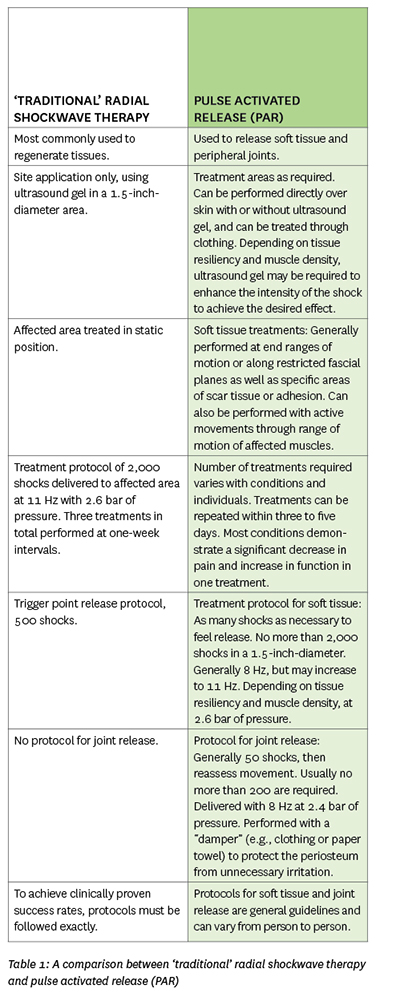
|
Other applications
Another key point that must be mentioned about PAR is the exposure issues related to treatment of the pelvic, groin and gluteal areas. Since clothing does not have to be removed for treatment, both the patient and practitioner are better protected from issues related to treating those areas. Spandex shorts or yoga type pants are the preferred choice for treatment purposes.
The condition I treat most successfully with PAR is plantar fasciitis – treating this condition demonstrates the best attributes of both “traditional” radial shockwave therapy and the PAR technique. There is a clinically proven 90 per cent success rate with the “traditional” application alone.
The use of the PAR technique also allows me to address joints and fascial restrictions of the feet, lower limbs and pelvis that inevitably accompany this condition. In this condition, they can be released simultaneously. The excellent success rate seen by using a combination of both, along with proprioceptive foot strengthening insoles, have made my clinic a preferred choice for many local practitioners to refer their patients with plantar fasciitis to.
Another aspect of the PAR technique is the ability to treat deeper structures without breaching the patient’s acceptable pain thresholds and without damaging superficial tissues. In most cases patients do not experience delayed onset muscle soreness. Additionally, it can minimize the need to subject joints to high velocity thrusting. Essentially, this technique is a gentle method of releasing peripheral joints.
Case studies
Pre- and post-treatment tests were performed to demonstrate the effectiveness of the soft tissue and joint release techniques. Quantitative data was collected using the Noraxon Clinical DTS Surface Electromyography (EMG) system. Treatments were performed with the Storz Medical MP50 Radial Shockwave machine.
Test 1: Soft tissue release
.jpg) |
|
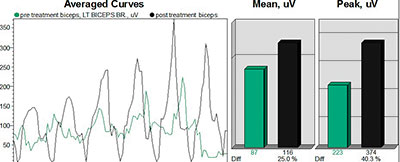 |
|
| Figure 1. Soft Tissue Release: Pre- and Post-treatment Data
|
Fifty-year-old male patient with a chronic partial tear of the left distal bicep.
Pre-treatment data was collected while performing five bicep curls with a five-pound weight in a seated position. Treatment was then applied to distal bicep directly over the skin with no ultrasound gel. One thousand two hundred shocks were delivered at 10 Hz with 2.6 bar of pressure.
Post-treatment data was collected immediately following with patient repeating five bicep curls using a five-pound weight in a seated position.
Note that the muscle activation report shows a 25 per cent increase in microvolts during the contraction phase and a significant improvement in the relaxation phase of the performed movement (green: pre-treatment, black: post treatment).
Test 2: Joint release
.jpg) |
|
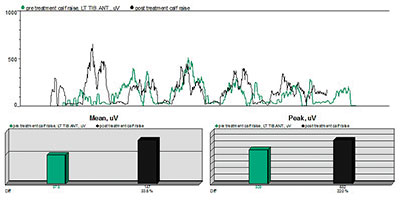 |
|
| Figure 2. Joint Release: Pre- and Post-treatment Data
|
Thirty-four-year-old female with restricted movement between the first cuneiform and the first metatarsal of the left foot.
Pre-treatment data was collected while performing five standing calf raises. Treatment was then applied over the sock at the base of the first metatarsal with 125 shocks delivered at 8 Hz with 2.4 bar of pressure. Post-treatment data was collected repeating five standing calf raises.
The muscle activation report shows an increase of 33.8 per cent of the tibialis anterior (green: pre-treatment, black: post treatment).
SUMMARY
The PAR technique:
- Less invasive on both patient and practitioner
- Nominal, if any, recovery time from deep treatment
- Initial testing with surface EMG indicates immediate and positive results
- Pharmaceutical-free pain relief
- Immediate increase in range of motion in most cases
- Can be performed over clothing
- Extended practitioner career
- Enhance your referral base
- Deeper treatment without exceeding patient’s pain threshold
Without question the PAR technique has significantly increased my success rates, revolutionized my practice, allowed me to continue working with some of the world’s best athletes, and given me career satisfaction beyond my expectations.
TESTIMONIAL
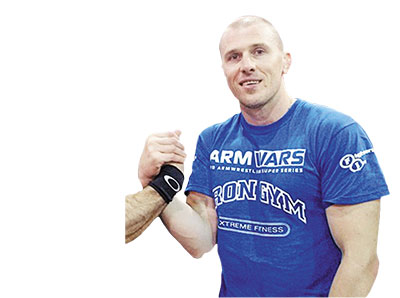
|
|
“I have tried both manual and instrument assisted approaches to rehabilitate my elbow injuries. Both methods hurt like hell, left bruising and took a number of days to recover from before I could train effectively again. In my game I can’t afford that much down time. Ultimately, the treatments were unable to resolve or get to the depth of my injury and I still had restricted range of motion.
“Nearly five years ago I tried the PAR technique with Scott and was truly amazed. My pain was almost eliminated in one treatment, it was deep without excessive discomfort and there was no down time to recover from the treatment itself.
I’m now competing at the top of my game and continue to capture
more titles!”
– Maksim Khodau, nine-time Canadian Arm Wrestling Champion, two-time bronze medallist, World Arm Wrestling Championships
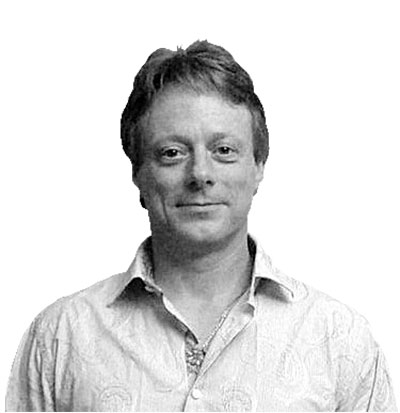 |
|
SCOTT GRISEWOOD, RMT, is owner/operator of Athletes Choice in Barrie, Ontario. In practice for the past 18 years, Scott continues to treat and train numerous world-class athletes in Canada and internationally.
Print this page